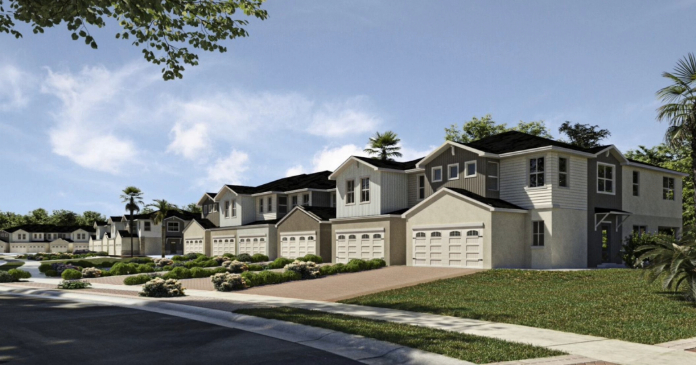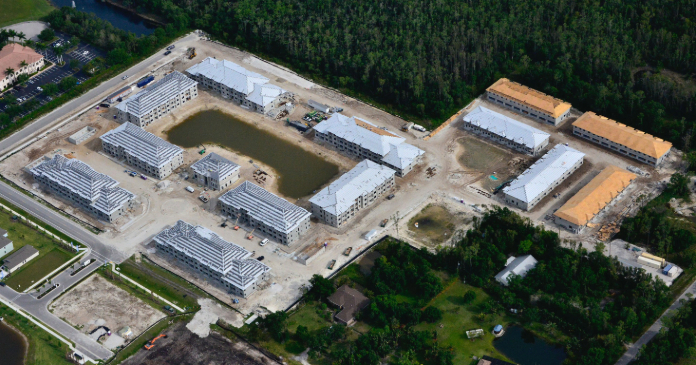“We think it’s a great time to grow these enterprises,” said UDR CEO Tom Toomey of the expansion in the apartment industry. “You can’t sit there and look at the wall of demand that keeps growing and not feel enthused about your investments and where they might be headed.
“I think the industry is facing an interesting and very intriguing set of new dynamics, with homeownership in America changing radically, and where that pendulum ultimately settles may redefine how all of us have traditionally underwritten and modeled this business,” he said in early May.
The factors driving the improvement in apartment fundamentals, said AvalonBay Communities CEO Bryce Blair, include the brightening employment scene, where 200,000 jobs a month are being created nationwide, with a composition that favors the apartment industry. A disproportionate share of the newly created jobs will provide employment to the under-35 age cohort, which has a high propensity to rent.
Over the past year, job growth for that younger age group has increased at a rate more than twice that of the economy as a whole. With more jobs, those recently employed echo boomers are moving out of Mom and Dad’s house or off the friend’s couch and into apartments of their own.
The weak for-sale market also is affecting rental demand positively, as the homeownership rate in the U.S. continues to fall, last quarter reaching a new low. The percentage of residents moving out of AvalonBay apartments to purchase homes fell 12 percent in Q1 2011 compared to 15 percent the previous quarter, and now is at the lowest level since the REIT began tracking that number. Historically, the REIT’s moveouts to homeownership have been in the low- to mid-20 percent range.
Meanwhile, there has been a sharp reduction in the supply of apartments, Blair noted. “Over the 10-year period from 1998 to 2008, there was an average of about 240,000 new rental completions per year. Last year, there were 160,000 and this year completions are expected to be below 80,000 units, which would make it a 50-year low,” he said.
That level of new completions is less than the annual estimated loss due to obsolescence, meaning that the industry is seeing a Net Zero increase in the stock at a time of high demand. “While history never repeats itself exactly, a little historical perspective is always helpful,” he said.
“The most recent expansion period for apartments was from mid-2004 through the end of 2008. Over this four-and-a-half year period, we saw revenue growth in our portfolio of just over 20 percent, cumulatively, with the peak year-over-year growth of about 7.5 percent.”
Not bad, but not nearly as strong as AvalonBay saw in the prior expansion period, which stretched from early 1994 to late 2001, he said, adding that it’s still too early to predict the duration of this growth period, since revenue growth turned positive for the REIT just two quarters ago.
And, the momentum is continuing with April revenues projected to be up around 4.5 percent, driven by an average rental rate increase of 4.8 percent, compared to April 2010, he said. Renewal rates continue to escalate, averaging around seven percent for May lease expirations and more than eight percent for June expirations, up from about five percent in March and April.
Regions with the highest year-over-year percentage renewal offer increases for June were Northern California, New York, New Jersey and New England, each of which posted increases of between nine and 9.5 percent.
Every region is experiencing acceleration in renewal increases, except in D.C., where renewal increases leveled off in the seven percent range in a market that recovered earlier than most. With recent improvement in Seattle and Southern California, every one of the regions in which AvalonBay is active is now experiencing improved performance.
“As the year progresses, we expect that the West Coast markets will continue to accelerate at a faster rate than the East Coast, although every region should continue to experience a healthy rate of growth,” said Blair.
AvalonBay is developing into that growth. In Q4 of last year, the REIT completed three communities for a total of $234 million. The average projected yield for the development portfolio has steadily improved over the last few quarters, with current projected yield now 6.8 percent, up 40 basis points from last quarter and should be around seven percent next quarter, he predicted.
Currently, the company has some $640 million of communities under construction, all of which were started in 2010, and recently authorized the start of construction for three communities totaling around $200 million, anticipating almost $900 million of construction starts for the full year.
“We have been aggressively taking advantage of our competitive position early in the cycle, when development economics are usually most attractive,” he said, adding that the company also is replenishing its pipeline, adding eight new development rights, totaling more than $500 million, this past quarter. Over the past two quarters, AvalonBay has added 14 development rights, totaling $950 million , to the pipeline, including two large mixed-use deals, totaling more than $200 million, in Boston and D.C.
In addition to those two deals, the REIT added three new development rights in New Jersey, where AvalonBay has three communities under construction and another 10 in design and entitlement stage.
And, the company was active last quarter on the transaction front, with acquisition of a 448-unit garden-style community in San Diego for $78 million and a 415-unit highrise in the D.C. market for $89 million in Falls Church, Va.
UDR is in growth mode, as well. Including development and redevelopment efforts, the REIT completed more than $1.3 million in transactions over the eightmonth period ending at the beginning of May, including the acquisition of five communities on both coasts in Q3 2010 and a March entry in to Manhattan with the $260.8 million acquisition of the 493-unit 10 Hanover Square.
The 23-story former headquarters of both Goldman Sachs and Kidder Peabody in Manhattan’s financial district that was built in 1969 and converted to residential in 2005 includes apartments that rent for an average of $3,000 and features nearly 42,000 square feet of retail space.
The residential tower offers studios, ones, twos and threes that average 708 sq. ft. and feature nine-foot ceilings, open floor plans, granite countertops, maple cabinets and solid oak wood flooring. Amenities include 24-hour concierge service, two lounges, a rooftop deck and discounted membership to a 28,000-sq.-ft. on-site fitness center.
“Our strategy is to own in areas with high barriers to entry, great job bases and a propensity to rent. Boston and New York were high on our list and, last fall, we bought two assets in Boston and we entered into joint ventures that increased our presence there. The New York purchase is the first of what we hope will be many,” said UDR senior VP and CFO David Messenger.
Equity Residential, buoyed up by improvement in turnover, occupancy and pricing power, purchased two apartment communities in Q1 for a total of $139 million, including a 225-unit apartment community in Fort Lauderdale, Fla., that is across the street from an existing asset the REIT owns there, for $200,000/unit, and a 296-unit community in Boston’s Back Bay, surrounded by numerous colleges, hospitals and other medical facilities, for $317,000/unit.
The REIT also purchased a commercial property in downtown Seattle. The plan is to operate the 97,000-sq.-ft. office and retail space as such while waiting for the demolition of an elevated highway immediately to the west of the property, the only barrier that separates the asset from Puget Sound.
Equity Residential sold 12 assets in the quarter for a total of $262 million located in Maryland, Atlanta, San Francisco’s East Bay, Phoenix and St. Petersburg. “The strong demand for assets has caused us to accelerate our disposition activity for the year,” Messenger said, adding that the REIT sold $530 million of assets in April alone, with the sale of a seven-property, 1,656-unit portfolio in the Metro D. C. area at the end of the month for $286 million.
Also in April, Equity Residential sold three assets in Portland, Ore., two in Phoenix and one each in Florida, Massachusetts and New Hampshire. The Manchester, N.H., sale marks the REIT’s exit from that market.
On the development side, the REIT started a 280-unit community in Los Angeles on land acquired in the mid-2000s, completed 250 units in Redmond, Wash., and expects to start this quarter on a JV development deal in Miami.
“We are looking for development opportunities in all our markets–Boston, South Florida, D.C., Southern California, the San Francisco Bay Area and Seattle,” Messenger said.
During Q1, Camden Property Trust acquired three properties for $123 million for the company’s fund, while selling the REIT’s interest in three Houston JVs, in a continuing effort to simplify the balance sheet, while ramping up development with $336 million under construction and more in the pipeline.
And the REIT is actively pushing rents while watching revenues grow. “There’s definitely been a change of attitude in the Camden latitudes and it’s about raising rents way more aggressively than we thought we could,” Ric Campo reported in late April.
“Thirteen of our 16 markets have had strong revenue and NOI growth,” Campo said. Only Houston and Las Vegas, which represent 16.2 percent of the REIT’s same store portfolio that stretches from the D.C. Metro to Los Angeles, had revenue declines. The average quarterly NOI growth across the company’s 47,600-unit same store portfolio was 6.2 percent.
“Apartment operating fundamentals continue to be the best we have seen in a long time,” he said, adding that Camden has increased full-year guidance as a result of the strength of core operations and continuing strong outlook.
The company is off to a great start in 2011, with the best year-over-year portfolio improvement in Q1 the REIT has ever seen. “Just to put it into perspective how far we’ve come in the last 12 months,” said Camden President Keith Oden, “In the first quarter of last year, NOI was down 9.1 percent and in Q1 2011, we’re up 6.2 percent. That’s more than a 1,500-basis point swing in a year.”
Occupancy, at 94.8 percent, is the highest level the REIT has seen since the middle of 2008 and traffic at Camden’s communities is up about nine percent over a year ago, across the company’s entire portfolio. And, despite aggressive renewal increases, Camden continued to see a historically low turnover rate of just 42 percent in Q1, compared to 44 percent a year ago and 50 percent in Q4.
And the percentage of residents moving out to home purchase also was historically low, dropping to 10.4 percent, breaking the all-time lows, set in the third and fourth quarters of last year.
“As the resident skeptic around here, it’s hard to find much to fret about in these numbers,” said Oden, who predicted that, barring unforeseen events, 2011, 12 and 13 will likely be the best three years for the apartment industry anyone has seen for many years.
“The surprise, so far, is that it appears to be unfolding at a faster pace than even the optimists anticipated,” he said.
Author Peggy Shaw
















